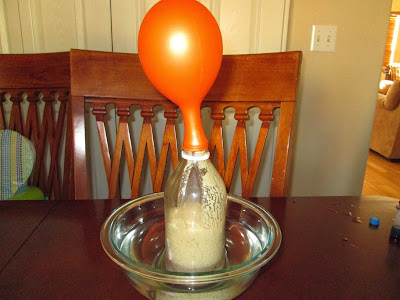Total Time: About 10 minutes to set up, then about an hour until completion
Difficulty: So easy even a four-year-old can do it
 Materials You Need:
Materials You Need:2 Tbsp dried yeast
1 Tbsp sugar
2 Tbsp lukewarm water
Glass bottle
Bowl half-full of lukewarm water
Balloon
Some kind of cup in which to mix our ingredients
Spoon
Directions:
- Mix together the yeast, sugar, and water in your cup. You may add more water if it's not runny enough to pour into your glass bottle. (Just be sure it's lukewarm, too!)
- Pour this mixture into your bottle.
- Quickly stretch the balloon over the mouth of the bottle.
- Set your bottle/balloon in the bowl of warm water and wait!
 |
| Our bubbly yeast mixture. That's how you know it's working! |
This is the exact same reaction that happens whenever someone makes bread, rolls, breadsticks, pizza crust, or cinnamon rolls. As the dough rises (AKA as this yeast reaction occurs) it produces carbon dioxide bubbles, but they get trapped inside the dough. This makes the dough expand, so when you bake it, you have a fluffy, soft texture to bite into. YUM!
Print These Instructions
 |
| The beginning of our reaction. Not much going on. |
 |
| After about 10 minutes the balloon was inflated enough to stand up on its own! |
 |
| After about 30 minutes. The balloon is bigger and the mixture is bubbling up higher. |
 |
| This is our experiment at equilibrium. You can see how high the mixture is in the bottle! Shortly after this it receded down, but the balloon stayed this inflated until we took it off the bottle. |












0 comments:
Post a Comment